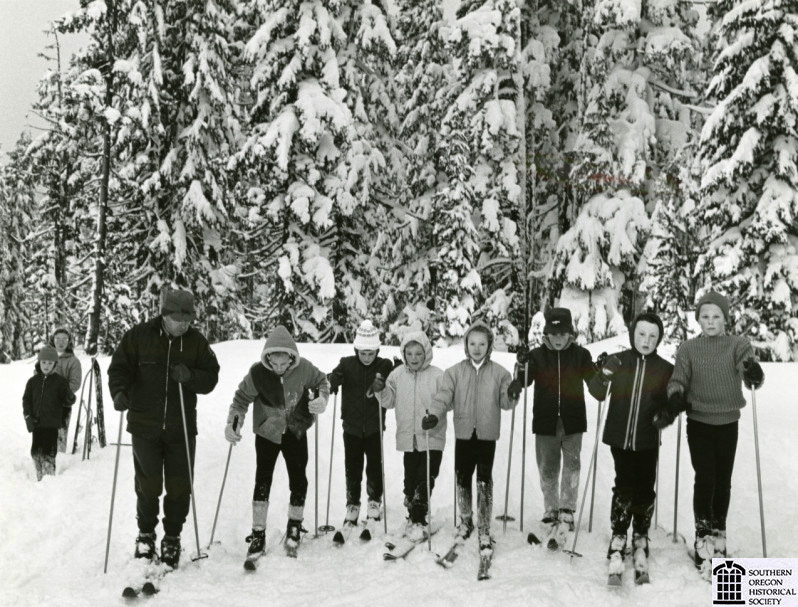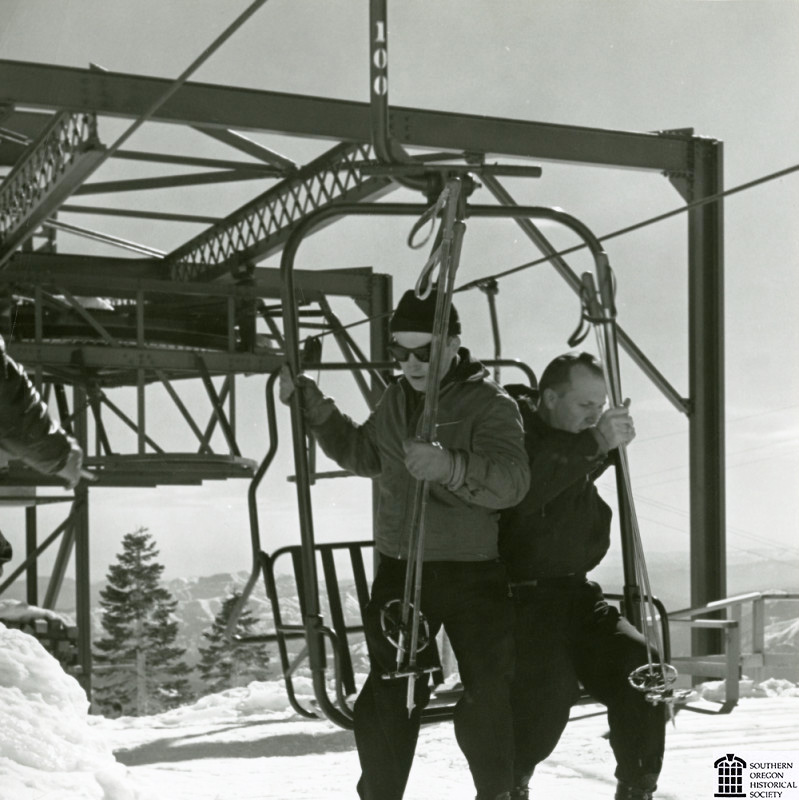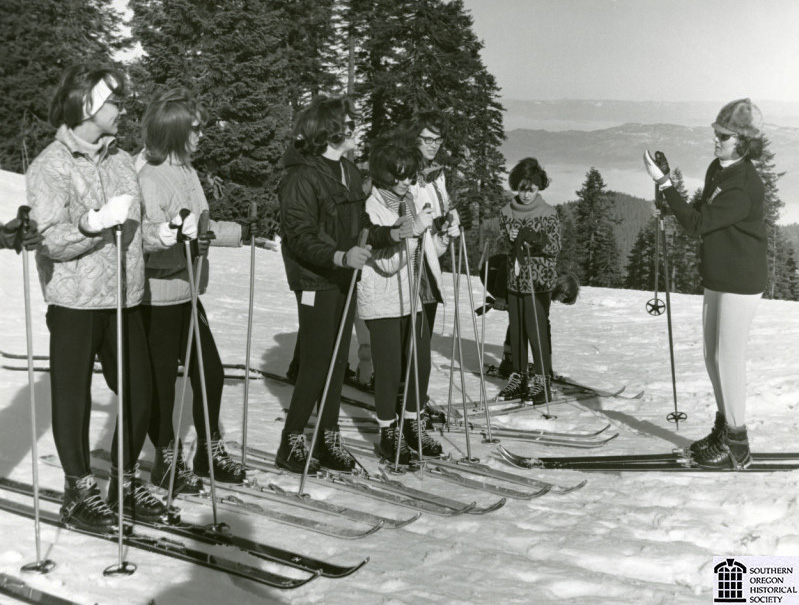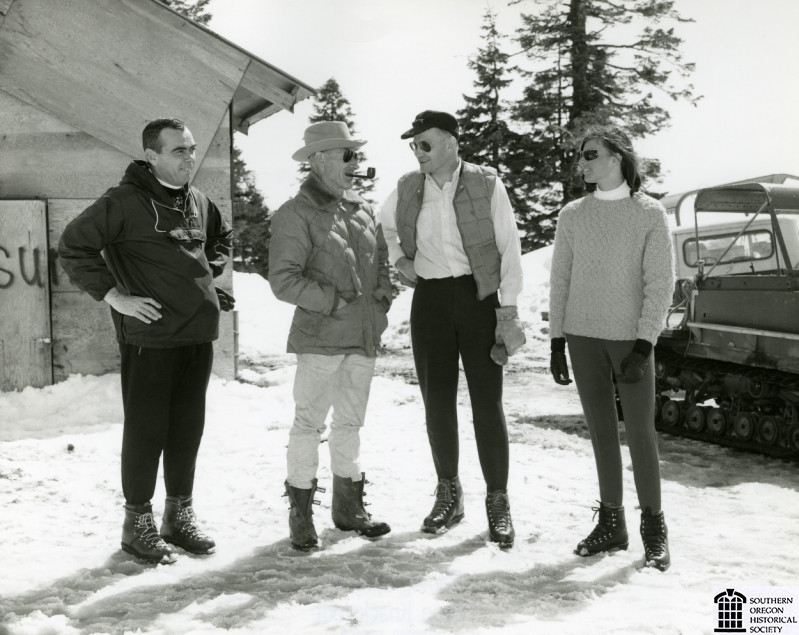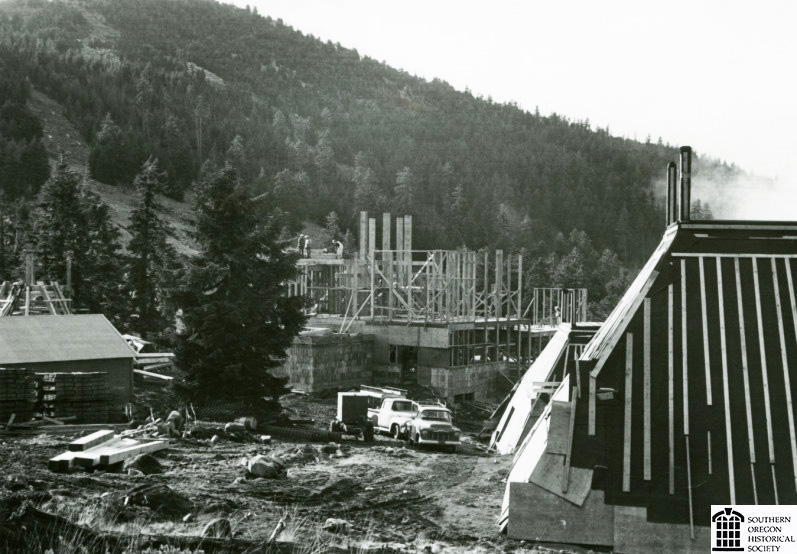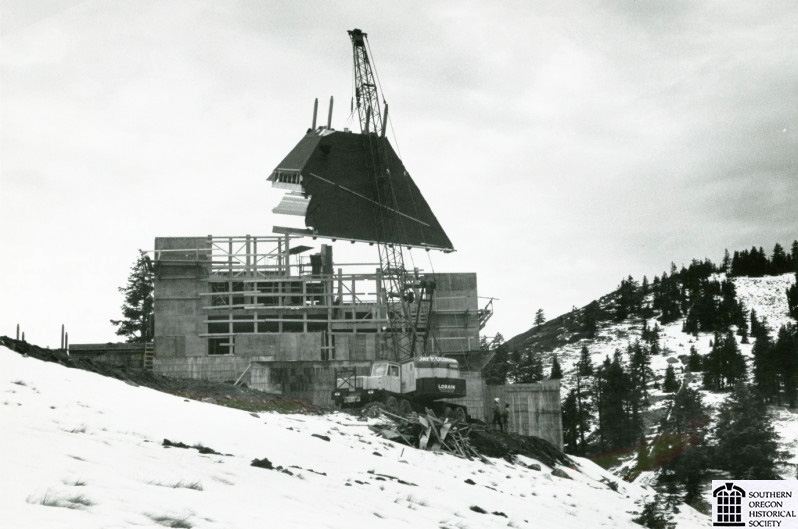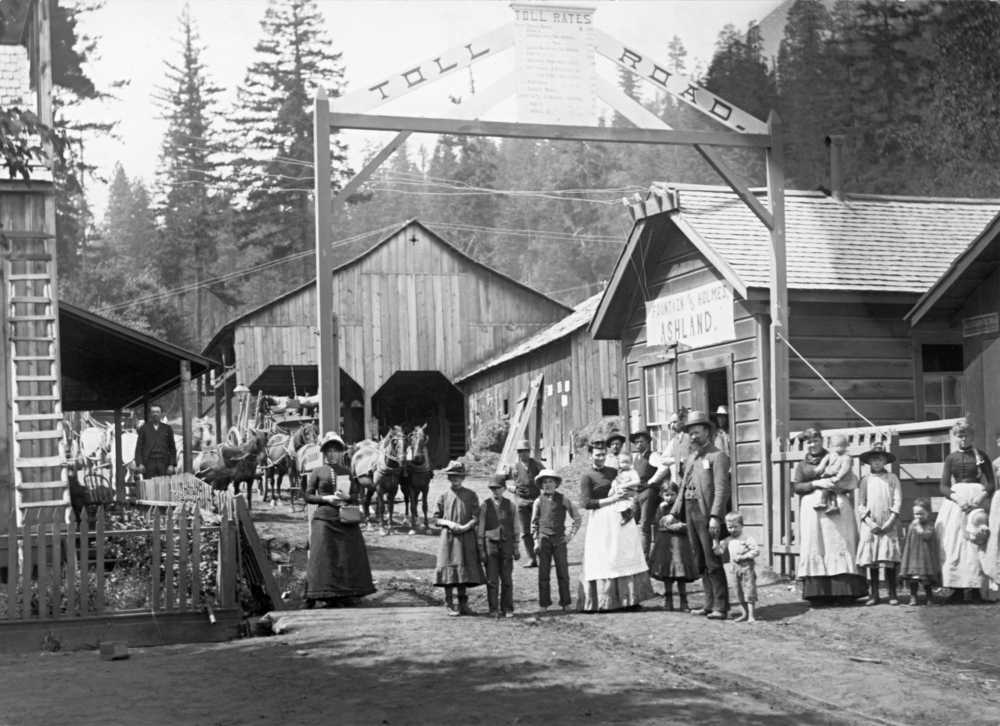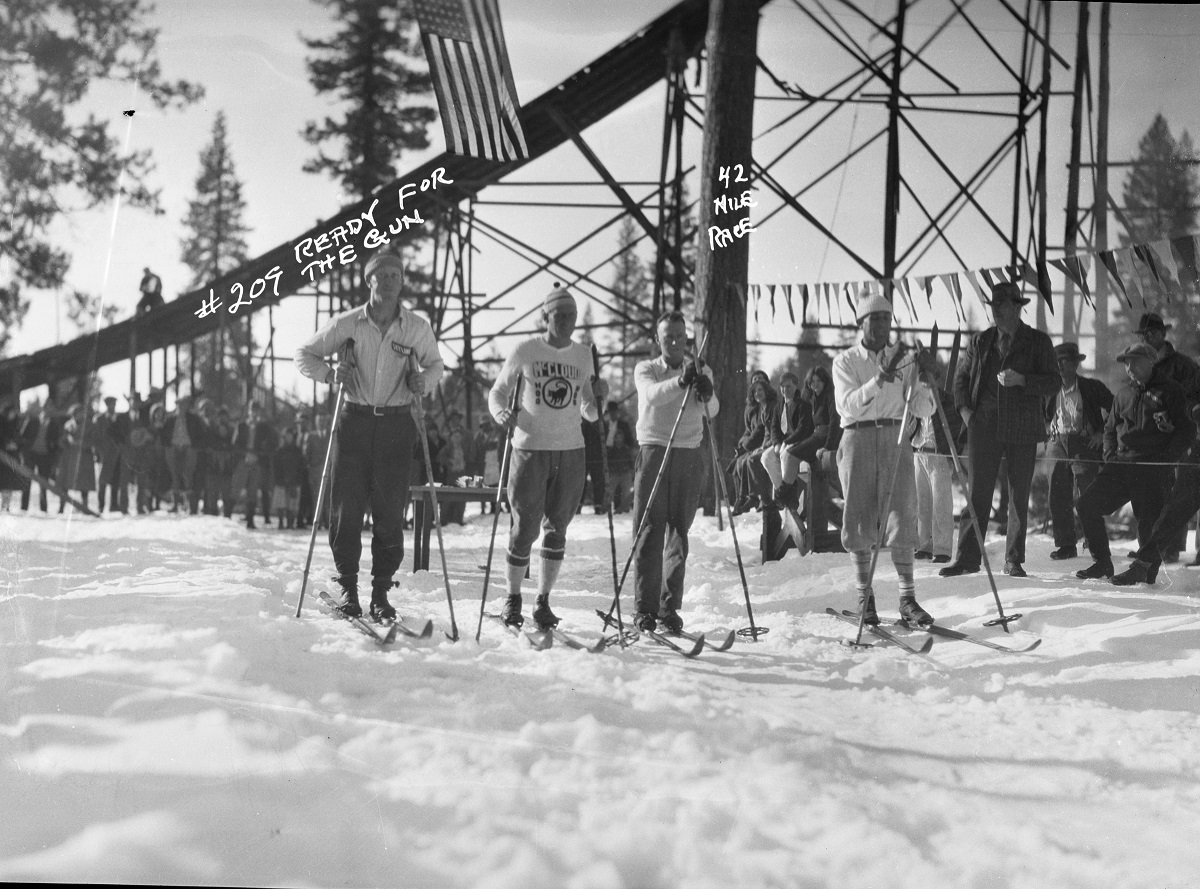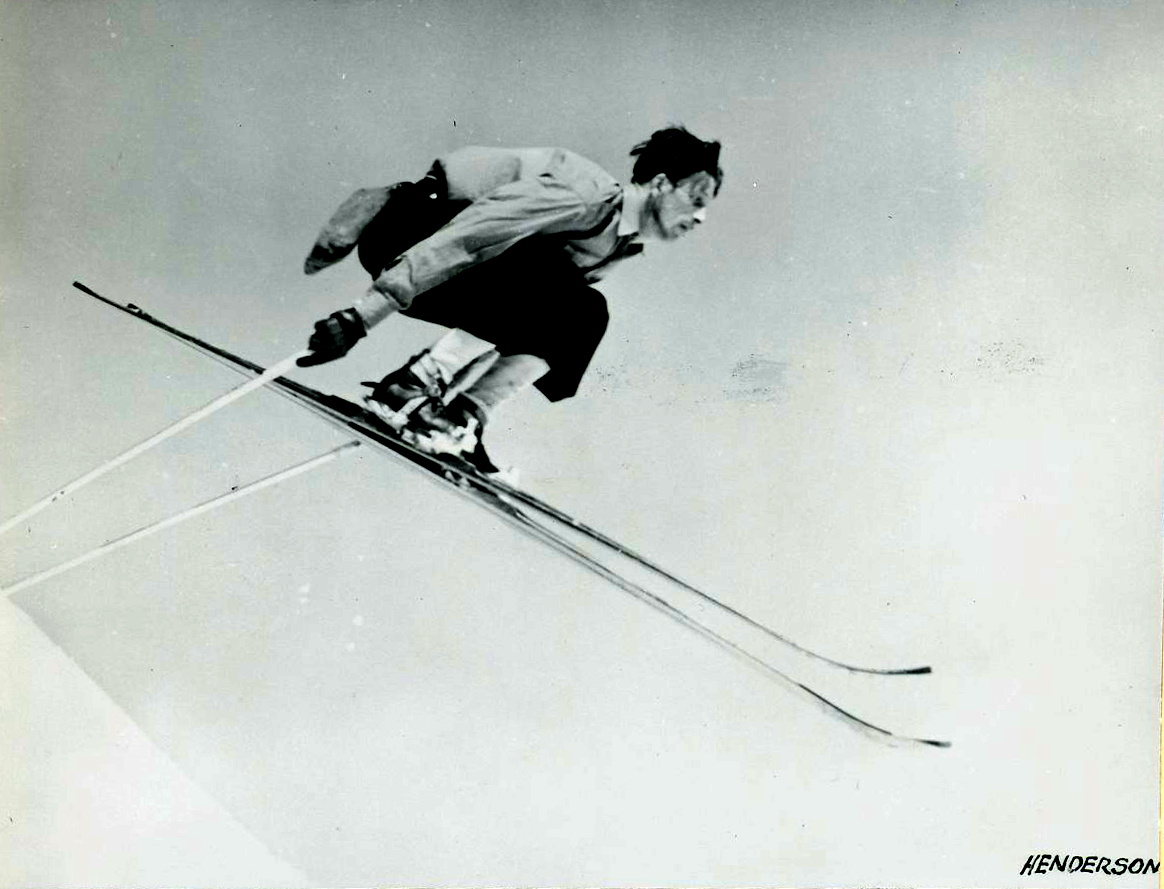The Mt. Ashland Ski Area, which encompasses over 240 acres of national forestland, is situated on and near the summit of Oregon’s highest peak west of the Cascade Range. Started largely by local ski enthusiasts, the ski area has been an important community asset since the early 1960s. With five lifts, forty-four ski runs, and a ski lodge, the area operates under a U.S. Forest Service special-use permit and draws clientele primarily from southwestern Oregon and northern California. The area is managed by the Mt. Ashland Association.
The first ski resort in America was Howelsen Hill, which opened in 1915 in Steamboat Springs, Colorado, but it was not until the 1930s that downhill skiing emerged as a popular pastime in the U.S. (Idaho’s Sun Valley, America’s first destination ski resort, opened in 1936). At about the same time, the number of downhill skiers was growing in Jackson County, Oregon, largely due to small groups of dedicated enthusiasts. Beginning in 1936, the Rogue Snowmen operated free rope tows, powered by portable gas engines, at Farewell Bend on the upper Rogue River and at Trail Camp, about three miles north of Mount Ashland. Both of those modest, family-focused endeavors were in the Rogue River National Forest at places where Civilian Conservation Corps (CCC) crews had built warming huts for skiers. Before long, Crater Lake National Park was welcoming skiers as well. By the 1950s, skiers could drive to Siskiyou Summit and pay to use a rope tow on private land off Highway 99.
By 1959, Rogue Valley skiers were chaining up their vehicles and making their way through deep snow to the CCC-built, unsurfaced Mount Ashland Loop Road to ski on the slope where Mt. Ashland Ski Area’s lodge would be built a few years later. The number of ski areas was increasing on national forestland throughout the West, and a group of Medford and Ashland citizens, including powerbroker Glenn Jackson, successfully lobbied the Forest Service for a ski-area permit on Mount Ashland. The Mt. Ashland Corporation, formed in 1961 with capital assets of $500,000, developed the ski area in 1962–1963.
The lodge was designed by Medford architect Robert Bosworth and was built by Batzer Construction, a local firm. Money generated by federal timber sales in Jackson County, made possible by the Oregon & California Land Act, paid for a paved, two-lane road (built by A. L. Stayton Inc. of Stayton, Oregon) that extended west from Highway 99 at Siskiyou Summit across eight miles of steep slopes. Even though work on the lodge and the road had not been completed, Mt. Ashland Ski Area opened with one chairlift on January 11, 1964. Ashland is the home of the Oregon Shakespeare Festival, and the lift was named Ariel after a character in The Tempest. The first official ski race took place in March.
Located about 150 miles from the Pacific Ocean, Mt. Ashland typically receives heavy wet snow, and winters can bring highly variable snowfall (as of 2024, the annual average was 265 inches). The terrain is challenging, and the area is subject to high winds that can shut down lifts. Local skiers often say, “If you can ski Mt. A, you can ski anywhere.” Over 75 percent of the runs are for advanced-intermediate or expert skiers, and only about 19 percent are classed novice to intermediate. As a result, some skiers have chosen to ski at Mt. Bachelor in Bend and Mt. Shasta in California, which may have contributed to Mt. Ashland's history of financial instability.
The Mt. Ashland Corporation was dissolved in 1970 after three consecutive years of winter drought. The Southern Oregon Ski Association, a nonprofit corporation formed by administrators at Southern Oregon College (now Southern Oregon University), ran the ski area while it “developed a long term solution for its successful operation.” The association operated the area for three years, and in 1977 Mt. Ashland Ski Area was sold to Richard Hicks, an avid skier from Grants Pass and the owner of a chain of regional supermarkets. In 1978, Hicks invested in a second chairlift, which he named Windsor. He kept the operation on an even keel through 1983, when the area was purchased by Harbor Properties, which owned the Stevens Pass Ski Area in Washington State. Harbor invested in lighting for night skiing and made other improvements.
In 1992, in the face of repeated winter droughts from 1988 to 1991, Harbor put the ski area up for sale. When no acceptable buyer stepped up, a group of skiers, nonprofits, and businesses raised over 1.6 million dollars to buy the Mt. Ashland Ski Area, and the City of Ashland took over the Forest Service special-use permit the area needed to operate. In 1998, the Mt. Ashland Association proposed a major expansion of the permit area in order to create more intermediate runs. The proposal encountered years of lawsuits on environmental grounds, including water quality, expansion into a roadless area, and possible effects on the habitat. In 2016, four years after the nonprofit Mt. Ashland Association took over the special-use permit, a federal court upheld the Forest Service’s decision to approve the expansion. As of 2023, none of the proposal's new runs and lifts had been announced.
As climate change affects the area, Mt. Ashland Association has initiated year-round activities, including weddings, concerts, and business meetings. The winter of 2022–2023 brought heavy snowfall, a record number of skiers and snowboarders (128,625), and a ski season that lasted into late April.
-
![Children's skiing class at Mt. Ashland, about 1965.]()
Mt. Ashland, ski class, kids, ca 1965.
Children's skiing class at Mt. Ashland, about 1965. Photo Medford Mail Tribune, Southern Oreg. Hist. Soc., SOHS01i_20839
-
![Mt. Ashland lodge and skiers, 1964.]()
Mt. Ashland, lodge, 1964.
Mt. Ashland lodge and skiers, 1964. Photo Kenn Knackstedt, Southern Oreg. Hist. Soc., SOHS01i_15810
-
![Mt. Ashland ski lift, about 1968.]()
Mt. Ashland, lift, ca 1968.
Mt. Ashland ski lift, about 1968. Photo Medford Mail Tribune, Southern Oreg. Hist. Soc., SOHS01i_20836
-
![Adult ski class on Mt. Ashland, 1965.]()
Mt. Ashland, ski class, 1965.
Adult ski class on Mt. Ashland, 1965. Photo Medford Mail Tribune, Southern Oreg. Hist. Soc., SOHS01i_20840
-
![Glenn Jackson (second from left) at Mt. Ashland, about 1965.]()
Jackson, Glenn, at Mt Ashland, ca 1965.
Glenn Jackson (second from left) at Mt. Ashland, about 1965. Photo Kenn Knackstedt, Southern Oreg. Hist. Soc., SOHS01i_18595
-
![Construction of Mt. Ashland lodge, 1963.]()
Mt. Ashland, lodge constr, 1963.
Construction of Mt. Ashland lodge, 1963. Photo Medford Mail Tribune, Southern Oreg. Hist. Soc., SOHS01i_13780
-
![Construction of Mt. Ashland lodge, 1963.]()
Mt. Ashland, lodge constr 2, 1963.
Construction of Mt. Ashland lodge, 1963. Photo Medford Mail Tribune, Southern Oreg. Hist. Soc., SOHS01i_13941
Related Entries
-
![Ashland]()
Ashland
Ashland, a city of 21,360 people in Jackson County, is situated in the …
-
![Fort Klamath to Crater Lake Ski Race, 1927-1938]()
Fort Klamath to Crater Lake Ski Race, 1927-1938
In February 1927, the forty-two-mile, round-trip, cross-country ski rac…
-
![Hjalmar Hvam (1902-1996)]()
Hjalmar Hvam (1902-1996)
Skiing enthusiasts in Portland just before World War II knew the name H…
-
![Mount Ashland]()
Mount Ashland
At 7,532 feet, Mount Ashland is the tallest mountain in Oregon west of …
Related Historical Records
Map This on the Oregon History WayFinder
The Oregon History Wayfinder is an interactive map that identifies significant places, people, and events in Oregon history.
Further Reading
LaLande, Jeff. Mount Ashland Lodge: Architectural Description and Historical Narrative Mitigation Documentation Prepared for the USDA Forest Service. Medford, Ore., 2018.
Mount Ashland, 1964-2014: Fifty Years of Family Alpine Fun. Mount Ashland Association, 2014.
"A New Winter Spirit for the West: The Story of Skiing on the National Forests." National Museum of Forest Service History Newsletter 34.1 (Winter 2022).
"Record of Decision: Mt. Ashland Ski Area Expansion." U.S. Forest Service, September 2004.
"Mt. Ashland Season Recap & Town Hall." Mt. Ashland Ski Area, 2023.



